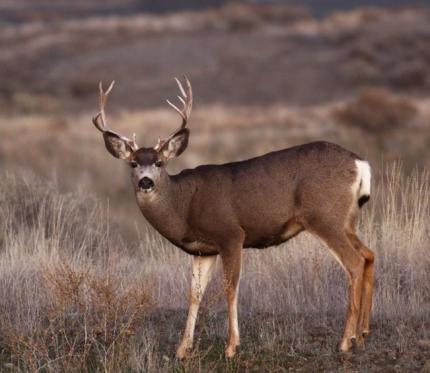
Wildlife Program report: Dec. 1-15, 2023
Providing Recreation Opportunities
Staff members have submitted a request for proposal to the Contracting Office for a route inventory and trail conditions assessment bid. The contract will hopefully be awarded in January or February of 2024. The contract includes a route inventory and trail conditions assessment at six wildlife areas.
Providing Education and Outreach
Staff members are preparing a request for proposal for an Ambassador Program 2024 bid process. Staff members are hoping to get the request for proposal posted before Dec. 23 to allow ample time for the bid process. Programming will hopefully run from April through August of 2024.
Staff members are continuing to work on kiosk development. In late December, 18 kiosks will be installed in Region 4. Ten more kiosks are currently in the design or fabrication process.
Managing Wildlife Populations
Columbia Basin Mule Deer: Biologist Brinkman conducted an additional ground-based mule deer survey around Rock Lake in District 2. Ground surveys are also conducted in Districts 4, 5, and 7, and are used to estimate post-season herd composition (for example fawn to doe and buck to doe ratios) for three subherds across the Columbia Basin. Aerial surveys continued this week for the Odessa subherd in parts of Lincoln and eastern Grant counties for population estimation. Biologists Lowe and Brinkman and Eastside Ungulate Specialist Bundick were able to fly a day and a half of surveys between periods of rain, snow, and heavy fog this week.

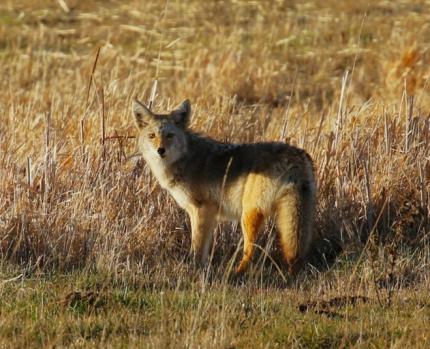
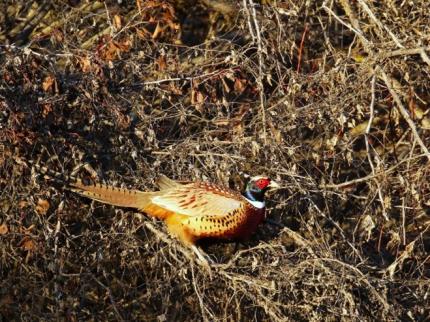
Providing Recreation Opportunities
Hunter Success: Private Lands Biologist Nizer received a harvest report from a hunter that hunted on Columbia Plataea Wildlife Management Association land. The hunter shot it on the last day of the late muzzleloader season.
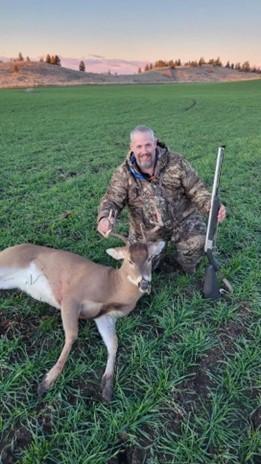
Turnbull Hunt By Reservation Success: Private Lands Biologist Nizer received a harvest report from a hunter that hunted on the hunt by reservation Turnbull Wildlife Refuge Long Lake Hunt.
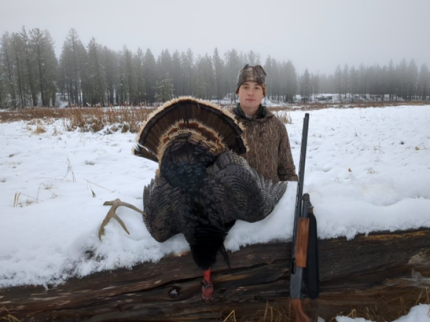
Access Site Maintenance: Access staff members went to Heller Bar and Joseph Creek on Monday to clean restrooms and pick up litter. They power washed and painted the walls of the toilets at Heller Bar. They also removed litter and leaves. They cleaned access sites across the district and checked the shooting range.


Providing Conflict Prevention and Education
Whitman County Elk: Wildlife Conflict Specialist Kolb responded to a complaint in southern Whitman County concerning 300 elk that were destroying fences, pasture ground, and commercial crops. Kolb conducted a site visit with the producer. The producer agreed to enter into a Damage Prevention Cooperative Agreement for additional tools and resources to address the on-going damage.
Cloverland Elk: Wildlife Conflict Specialist Wade spent one day in the Cloverland area after receiving a report that a large herd of elk had been seen in the area. Wade located roughly 100 head of elk in the area where they were reported. The elk were in a non-crop area and muddy conditions in the area were not conducive to hazing. Wade and Natural Resource Technician Heitstuman monitored the elk and will start hazing when conditions approve.
Conserving Natural Landscapes
Water Trough Escape Ladders: Natural Resource Technician Meisner spent the week replacing rotten escape ladders in water troughs scattered across the wildlife area. The old steel ladders rusted out and were not useable for birds or small mammals. Without the ladders, they could become trapped and perish in the water troughs. The new ladders are aluminum versus steel so they will have a longer lifespan. The design is essentially a metal mesh that angles down into the water. When birds or small mammals fall into the water, they can climb out. He also checked winter gate closures and facilities.
Habitat Plantings: Private Lands Biologist Hadley planted shrubs on a Feel Free to Hunt access site in Walla Walla County and met with a member of the Blue Mountain Pheasants Forever Chapter to plan volunteer dates. They plan to plant shrubs and do other site prep work on multiple Washington Department of Fish and Wildlife contracted access sites in Columbia and Walla Walla counties. Private Lands Biologist Hadley contacted landowners to notify them of planned work dates.
Aquatic Lands Enhancement Account (ALEA) Grant Planning Meeting: This week Wildlife Area Assistant Manager Rimmelspacher and Wildlife Area Manager Finch attended monthly meeting of the Spokane Chapter of Pheasant Forever in Spokane. Spokane Audubon Haggin and ALEA Grant Manager Thorburn were present at the meeting to discuss the terms of the grant. The purpose of the meeting was to plan the winter riparian shrub planting that will take place in the Lake Creek Drainage on the east side of Z-Lake. In September, Rimmelspacher placed a shrub order that included over 750 trees and shrubs. Shrub matting will be used along with deer fencing to protect the plants. The estimated time for planting will be mid-April of 2024. The Bureau of Land Management has done very similar work in the same drainage over the last few years and has been very successful.
Camp Wooten Environmental Learning Center: State Parks staff members completed the project at Camp Wooten to put the creek, that comes out of the draw behind the park, back into its historic channel where it will by-pass the park to the north and reduce the risk of gulley-washers damaging anymore of the buildings. Dingman used some leftover seed to seed the disturbed areas for State Parks.
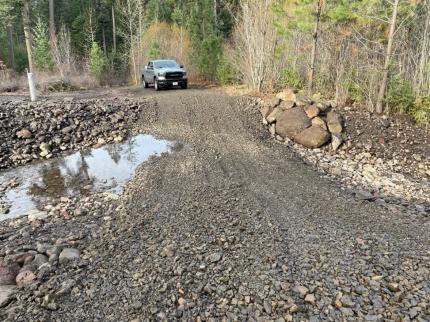
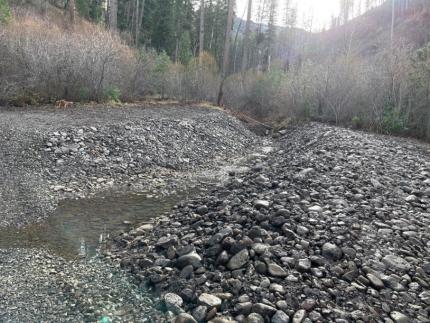
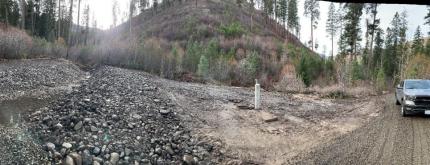
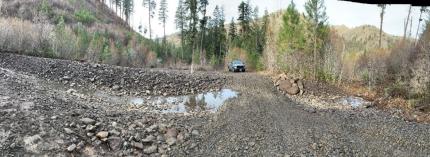
North Spokane Natural Area Corridor: There is a lot happening behind the scenes near Waikiki Springs Wildlife Area, located along the Little Spokane River on the north edge of the city of Spokane. The Spokane Tribe of Indians (STOI) recently purchased some land near the Inland Northwest Lands Council’s (INLC) Nature Preserve. The Inland Northwest Lands Council’s land lies adjacent to the wildlife area. Washington State Parks Department is also working on acquiring about 1,000 acres, called the Glen Tana property, in the same general area. With these new acquisitions, there will be a natural area corridor connecting Washington Department of Fish and Wildlife Waikiki Springs Wildlife Area, INLC’s Waikiki Springs Nature Preserve, the STOI property, a chunk of Kalispel Tribe property next to their golf course, Washington State Parks’ Glen Tana property, and Riverside State Park.
Dziekan and Regional Wildlife Program Manager Robinette represented Washington Department of Fish and Wildlife in a meeting about management of these publicly accessible parcels. Representatives from the four other organizations, State Parks, INLC, STOI, and the Kalispel Tribe also attended. After a general introduction, they discussed how each organization currently manages its lands in the area, and how future partnerships between all five organizations can improve habitat management and possibly bring about co-management of these lands.
Providing Education and Outreach
Waikiki Springs Presentation: On Thursday, Dec. 7, North Region 1 Access Areas Manager Dziekan gave a brief presentation at the closing portion of the Lands Division meeting in Ellensburg. He discussed the unique status of Waikiki Springs Access Area, which is used more like a city park and is being transitioned into a wildlife area.
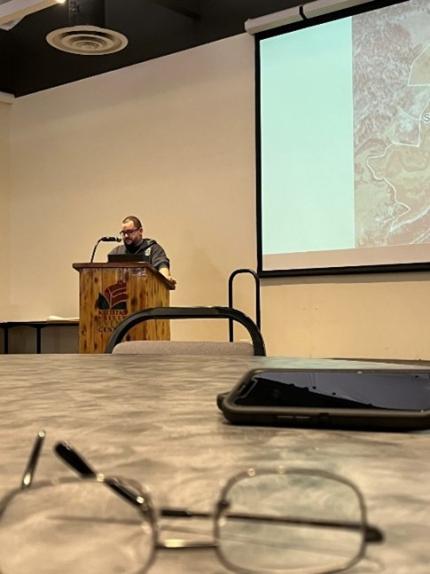
Volunteer Coordination: Wildlife Conflict Specialist Kolb conducted the final coordination with a Washington State University wildlife ecology student before they started their volunteer work in District 3. The student will have volunteer opportunities in every Washington Department of Fish and Wildlife program during their work period.
Managing Wildlife Populations
Deer Management: Biologists Dougherty and Clements finished assisting additional biologists on mule deer aerial surveys within the Odessa subherd. Weather played a large factor in being able to get up in the air to complete these surveys. Fog grounded the crew for several hours, and a snowstorm/fog combination caused a cancellation of flights for the day altogether.


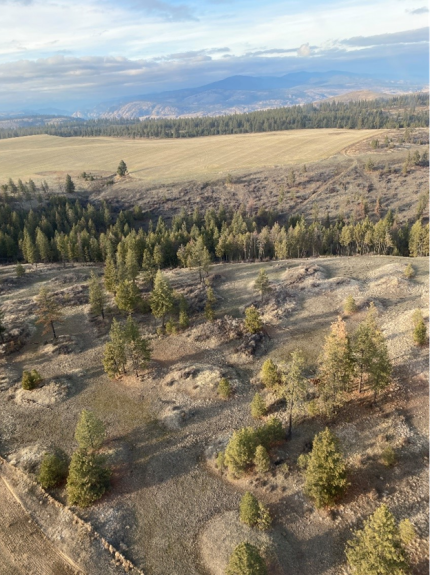
Mule Deer Aerial Surveys: Biologists Jeffreys and Eilers kicked off a multiday aerial winter range survey of the Chelan and Wenatchee Mountains mule deer subherds. The Chelan and Wenatchee Mountains subherds are both part of Washington’s East Slope Cascades mule deer population found in Okanogan and Kittitas counties.
The goal of these aerial surveys is to get an abundance estimate for the Chelan and Wenatchee Mountains subherds. Ratio data will be generated from these aerial observations to assess age and sex composition of the herds. Wildlife biologists use these data to inform management decisions and harvest regulations. In the case of the Wenatchee Mountains subherd, biologists will compare ratios gathered from these aerial surveys with those collected via images captured by 15 remote cameras placed along migratory routes crossing Highway 97 between Peshastin and Blewett Pass.
The surveys are timed to fall in the narrow window between the end of hunting season and the onset of antler shedding, after which time it becomes impossible to reliably differentiate between bucks and does. As is often the case in Chelan County during this time of year, low hanging clouds and patchy fog delayed the first day of surveys. However, Biologists Eilers and Jeffreys did manage to survey subunits in the foothills south of Cashmere and Monitor and in the Wenatchee Foothills at Horse Lake, Sage Hills, and Number One Canyon areas.

Mule Deer Ground Surveys: Biologists Eilers, Jeffreys, and several other Washington Department of Fish and Wildlife staff members in District 7 drove routes within predetermined units dividing up Douglas County to record the ages and sexes of all mule deer observed along the way. Unlike aerial surveys, these surveys are not used for population estimates, but instead to assess sex and age ratios, such as fawn to doe and buck to doe ratios. These ratios help biologists monitor the health and reproductive success of deer populations and aid in setting hunting regulations.
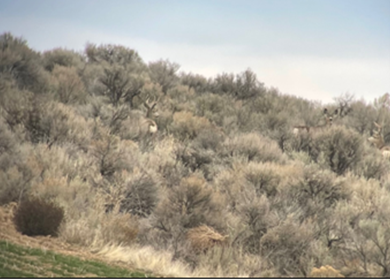
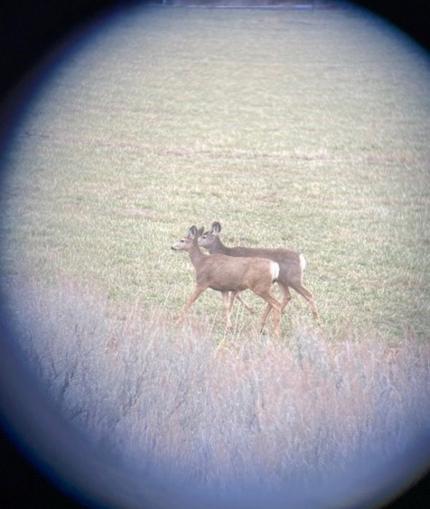
Annual Deer Surveys: Private Lands Biologist Braaten and District 7 staff members conducted annual deer surveys in Douglas County this period. Private Lands biologists classified 117 mule deer. There were 76 does, 28 fawns, and 13 bucks.

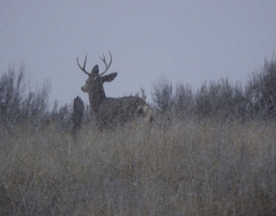
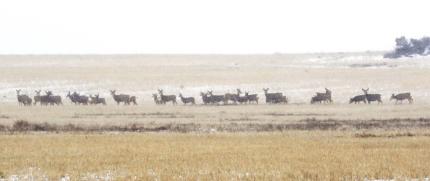

Upland Hunting ‒Trapped, Sick and Injured Wildlife: Biologist Clements responded to a call about a deer that was trapped in the east low canal with a broken leg. Biologist Clements, Officer Sullivan, and Wildlife Area Manager Eidson euthanized and removed the young deer from the canal.

Northern Leopard Frogs: Biologist Nason has been summarizing northern leopard frog data for the year-end project report and has been planning for several projects related to the 2024 field season. Upcoming projects include in situ rearing of northern leopard frogs, PIT-tag monitoring, adding a second translocation site, and bullfrog management.
Waterfowl: Biologist Clements has been responding to several harvest reports of GPS collared cackling geese. Clements has retrieved six collars within the last month. Replica collars have been given to hunters who turn in their harvested collars, and a certificate and map will be issued to them via email from Michael Guttery, a biologist in Alaska.
Biologists Dougherty, Clements, and Nason also participated in the annual winter snow goose and swan flyoff count. It was estimated that there were a minimum of 45,000 snow geese utilizing the open water in the Columbia Basin mid-December this year.
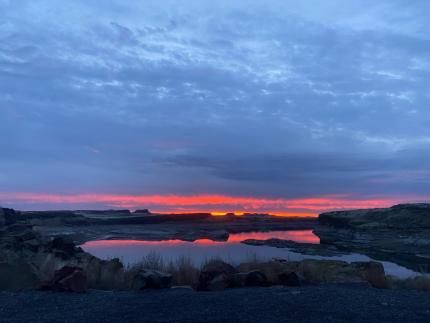

Managing Wildlife Populations
Kahlotus Deer Survey: District 4 Wildlife Conflict Specialist Hand, Region 3 Private Lands Biologist Manderbach, District 4 Wildlife Biologist Fidorra, and District 4 Habitat Biologist Maikis completed a roadside post-season deer survey in GMU 381. Weather conditions were optimal this year and an acceptable number of deer were classified.
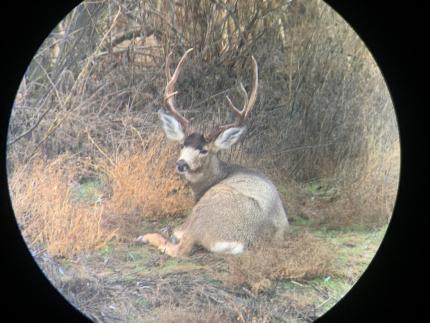
L.T. Murray Wildlife Area Winter Elk Closure: The L.T. Murray Wildlife Area crew closed gates and posted signs around the winter elk feeding closure area. Natural Resource Technician Blore and Natural Resource Scientist Nass built rock jacks to hold the newly configured sign boards for the closure. The rock jacks are a non-ground disturbing method of replacing t-post that held the signs on heavy plywood backing in the past.

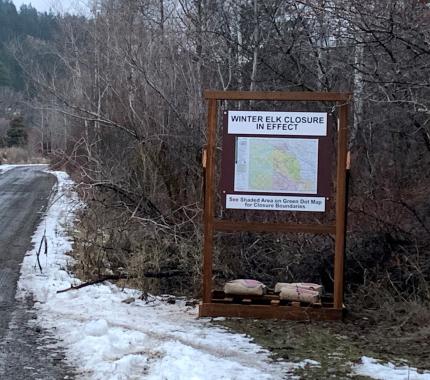
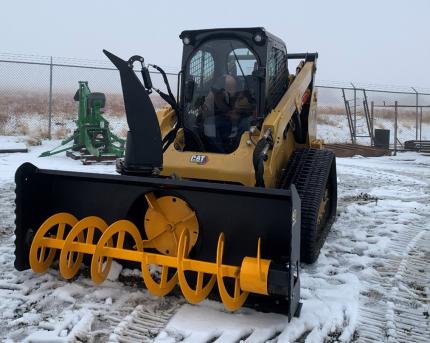
Oak Creek Wildlife Area Seasonal Closures: Oak Creek Wildlife Area winter feeding area closures went into effect on Dec. 15 at 5 p.m. and will remain in effect until May 1, 2024, at 6 a.m. Oak Creek Wildlife Area Manager Mackey and Natural Resource Technician Boggs closed and locked all of the seasonal closure gates at Oak Creek Road (FS 1400), Bethel Ridge Tie Road, and Mud Lake on Dec. 15.
Columbia Basin White Bird Surveys: Sunnyside Snake River Wildlife Area Assistant Manager Jahns and Region 3 Private Lands Biologist Manderbach assisted with the 2023 Columbia Basin White Bird Survey by conducting roost surveys at two locations in Franklin County. No swans were seen, but plenty of snow geese were around.
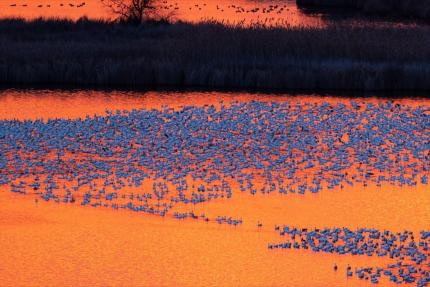
District 8 Jackrabbit Research: District 8 Biologists conducted white-tailed and black-tailed jackrabbit DNA sampling. Results are being processed through a collaborative project with the University of Idaho.
District 8 Bighorn Sheep Monitoring: District 8 biologists continue to monitor collared bighorn sheep activity, health, and status. A collared adult ewe was harvested during the 2023 hunt season and was confirmed positive for M. Ovi this week. Further laboratory tests determined the animal showed signs of chronic infection with the presence of nasal tumors.
Providing Recreation Opportunities
Wenas Wildlife Area – Buffalo Road Kiosk Installation: Wenas Wildlife Area Assistant Manager Taylor and Natural Resource Technicians Stoltenow and Janes installed a kiosk at the lower access to the Buffalo Road portion of the wildlife area. A compact loader was used to auger the holes for the legs and lift the kiosk into place. The road leads to the trailhead for the skyline trail and is a popular section of the wildlife area.
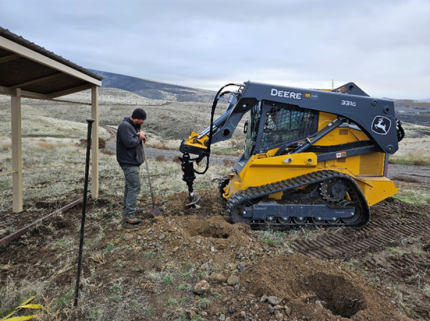
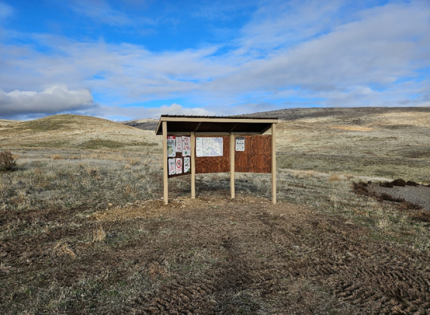
Private Lands Waterfowl Hunting Opportunities: Region 3 Private Lands Biologist Manderbach recently got the Meals Road and Snake River Department of Natural Resources waterfowl ‘Hunt By Reservation’ sites up and running. There are two fields open for reservation at Meals Road and three fields available on Snake River Department of Natural Resource land. Many calls have been fielded regarding these sites as they are very popular for goose hunting. Calls have slowed down now that reservations are active on the Private Land’s website.
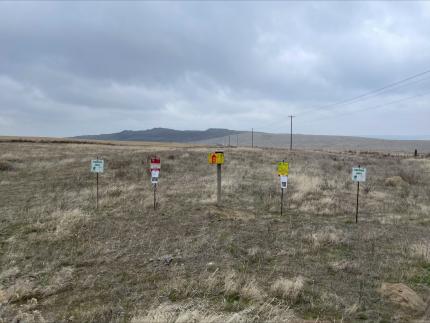

Providing Conflict Prevention and Education
Rattlesnake Hills Elk: District 4 Wildlife Conflict Specialist Hand monitored elk activity on Rattlesnake Mountain and coordinated with landowners on winter wheat crop success, hazing strategies, and damage permit issuance.
Kahlotus Deer Damage: District 4 Wildlife Conflict Specialist Hand received a new deer damage complaint from a wheat producer in the Kahlotus area. The landowner’s 1400 acres of newly planted wheat is being browsed on by between 50 and 100 head of deer. Active non-lethal hazing is becoming less effective. A Damage Prevention Cooperative Agreement was developed and associated damage permits were issued. Additional hunting pressure by special permit youth hunters is currently being planned.
Damage Prevention Cooperative Agreement (DPCA): District 4 Wildlife Conflict Specialist Hand completed two renewal contracts for landowners in Benton County. One DPCA addressed elk damage to hay and vineyard crops near Hanford and the other addresses deer damage to wine grapes along the Yakima River.
Pasco Deer Damage: District 4 Wildlife Conflict Specialist Hand prepared and delivered damage permits to a large tree fruit and wine grape operation north of Pasco along the Columbia River where increasing numbers of deer are browsing on new tree and vine growth.
Conserving Natural Landscapes
Wenas Wildlife Area - Bull Pasture Restoration: The Wenas Wildlife Area finished work restoring approximately 130 acres off Bull Pasture Road into native grass seed for 2023. Natural resource Technician Janes finished seeding and harrowing the area in the beginning of December.
Oak Creek Wildlife Area Bear Canyon Pile Burning: Oak Creek Wildlife Area Assistant Manager Charlet burned piles on the newly acquired Bear Canyon property. Piles consisted of nonnative vegetation removed earlier this year by volunteers.
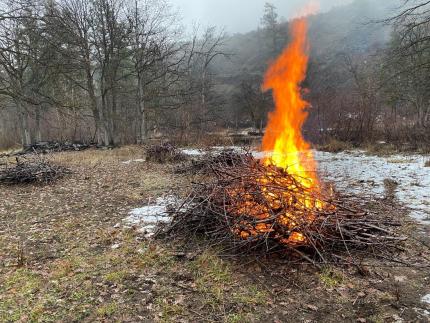
Other
Weed Control Seminar: L.T. Murray Wildlife Area Assistant Manager Winegeart attended a weed control seminar and has decided to use a mix of Method 240SL and Esplanade 200SC for bare ground control next year. This replaces Portfolio 4F in the mix and Method has better control of Russian thistle and knapweeds.
Mesa Lake Cultural Resource Survey: Sunnyside-Snake River Wildlife Area Assistant Manager Jahns met with Washington State Department of Fish and Wildlife archeologists to conduct the cultural resource fieldwork for the Mesa Lake Pac-man Wetland development project. The upcoming project, a Ducks Unlimited collaboration, will enhance and restore wetland habitat in the Mesa Lake Unit and provide connectivity between existing wetlands. In addition to surveying for the Mesa Lake project, fieldwork was also completed to install new kiosks at both the Mesa Lake and Bailie units.

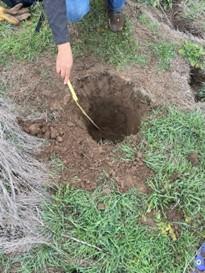
Managing Wildlife Populations
Deer Mortality Trail Camera: Wildlife Conflict Specialist Jacobsen and Biologist Wickhem investigated a mortality of a collared mule deer in west Klickitat County a couple of weeks ago. The deer likely died of hemorrhagic disease.
They placed a trail camera over the carcass. Columbia Land Trust staff members retrieved the camera for the Department of Fish and Wildlife. Several interesting trail camera videos were captured, including videos of cougars, skunks, ravens, multiple golden eagles, bald eagles, and black bear.

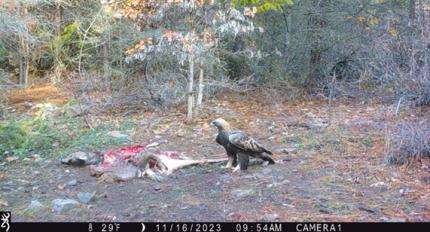
Klickitat Mule Deer Aerial Surveys: During the week of Dec. 11, Biologists Wickhem, Bergh, Holman, Jacobsen and Bundick conducted annual helicopter surveys for Klickitat mule deer. The survey consists of flying transects over 15 randomly selected survey units in Klickitat County between the Klickitat River and the eastern boundary of the county. When a group of deer is located, they are counted and classified (age, sex, and number of antler points, if present). Several other covariates are also collected including vegetation type, amount of cover, amount of snow, etc. These data are put into a statistical model (Idaho Sightability Model) which will calculate a population estimate for the herd. Those results will be reported in the near future. Other notable sightings during the survey included one cougar, many coyotes, a herd of 66 pronghorn, lots of turkeys, more than 60 elk, several raptors, and nine study deer wearing GPS-collars.
Thanks to the flight crew for their hard work, to Customer Service Specialists Splitgerber, Rainwaters and Kean for flight-following, Wildlife Area Manager VanLeuven and Officers Nelson and Bolton for daily weather reports, and especially to Pilot Emerson from JL Aviation for safe and effective flying!
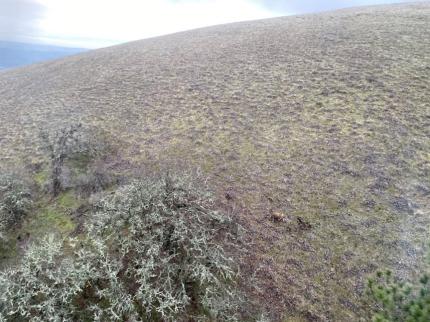
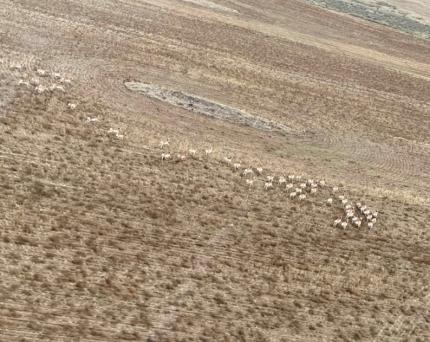
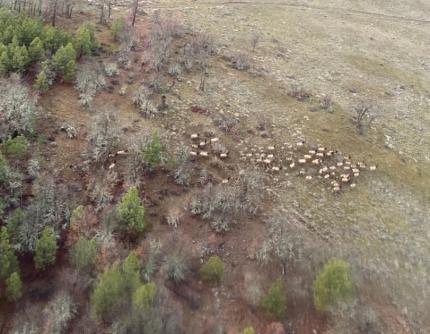
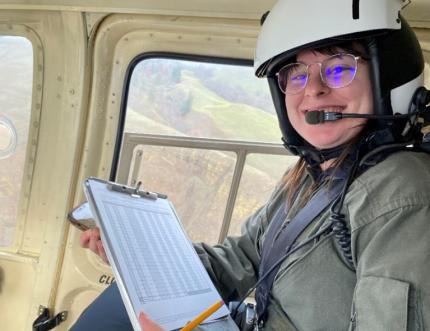
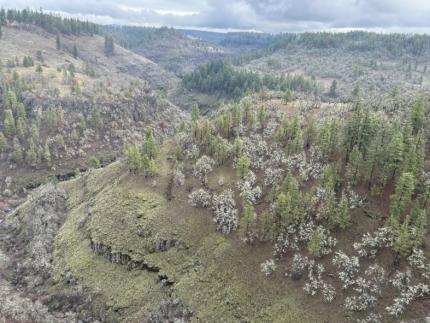
Providing Recreation Opportunities
Fishing Access: Private Lands Biologist Gray met with representatives from Weyerhaeuser Timber Company and Fish and Wildlife Officer Sargent Anderson to identify areas along the Toutle and Green rivers to enroll into an access agreement with the Department of Fish and Wildlife. These sites would provide free fishing access to the public. Check out the Private Lands property listing website this spring for more site details.

Interstate 5 Access Area: With the recent rain event last week, Natural Resource Technician Celaya is vigilantly inspecting sites for hazards to the public. For example, the I-5 access area in Lewis County has two massive cottonwood trees near the restroom and parking area, one of which had a large limb hung up in the branches above one of the parking spots. Celaya was able to safely mitigate the hazard.
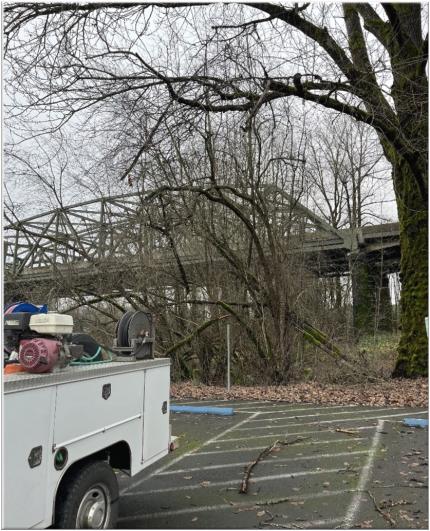
Hand Access Area: Recent heavy rains caused some issues at various access areas including Hand Access Area on the upper Kalama River. The river spilled into the parking area and brought with it mud and some logs. Thankfully only part of the parking area was covered, and access staff members have already started the clean-up effort. The ramps along the Kalama River have the normal silt build up but, so far, no erosion issues have resulted from the rising river.
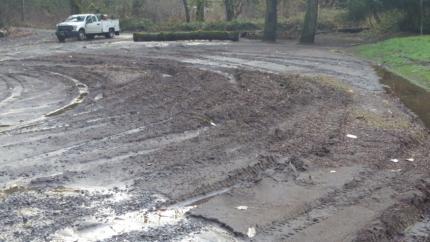
Modrow Bridge Access Area: Recently the Modrow Bridge Access Area suffered abuse by people. The restroom vault door lock had been cut off and the vault was filled with garbage and what appears to be the waste from a recreation vehicle black water tank. The liquid waste will need to be pumped out and then a vactor truck will be needed to remove the garbage. A vactor truck has a large, mounted tank and an 8” to 10” hose that will be used to suck out the rest of the waste. Unfortunately, it will cost approximately $2000 to clean out the restroom once both the liquids and garbage are removed.
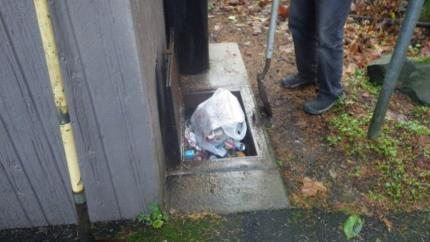
Providing Conflict Prevention and Education
District 9 Cougar Concerns: This week, Wildlife Conflict Specialist Jacobsen received multiple reports of cougar detections by home security cameras. One report did turn out to be a confirmed cougar detection, while the other turned out to be Mr. Fluffernoodles, a domestic house cat.
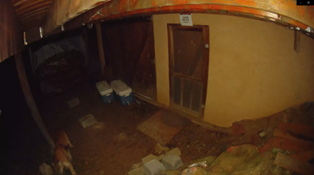
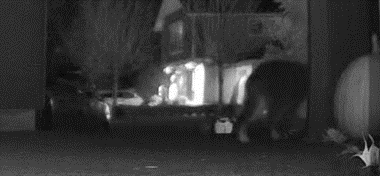
District 10 Injured Elk: Aubrey responded to a report of an immobile elk in a field, believed to be caused by Treponeme associated hoof disease (TAHD). Upon arrival, the elk had already passed and did have infected hooves. One of the neighbors wanted to salvage the animal so they were given a donation form. The elk was removed by the neighbor.
District 10 Injured Deer: Aubrey responded to a report of an injured deer that had been hit by a vehicle. The deer was dispatched and the carcass disposed of.
District 10 Bear Concerns: Aubrey received complaints from multiple areas about bears getting into trash and other attractants. Aubrey gave advice on securing attractants and hazing options.
Conserving Natural Landscapes
Mudflow Unit, Mt. St. Helens Wildlife Area: On the first day of December, Assistant Manager Risley and Technician Crane posted signs at the Mudflow Unit of the Mt. St. Helens Wildlife Area for the winter closure.
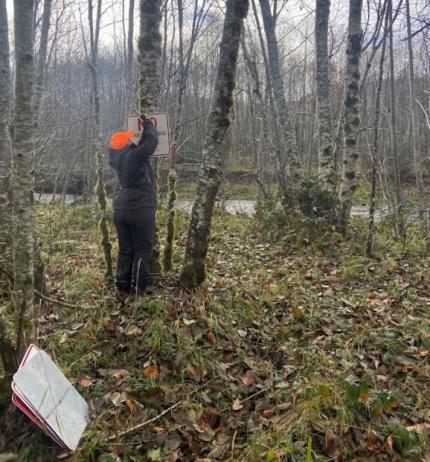
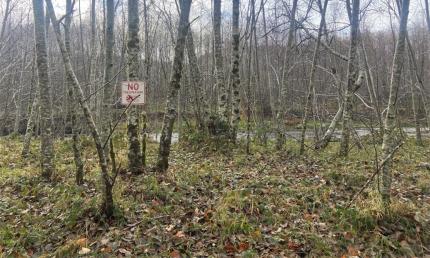
The Mudflow Unit is the only unit in the Mt. St. Helens Wildlife Area that closes seasonally for the protection of elk during the winter. The Mudflow Unit has been used by the Mt. St. Helens elk herd as over wintering grounds for generations. In recent years, Wildlife area staff members have observed as many as 350 individual elk using the Mudflow in a single day. Washington Department of Fish and Wildlife made the decision to close the unit to the public during the winter months to reduce stress to the elk during a critical time when available food and other resources are low. This closure is in effect from Dec. 1 through April 30 of the following year. Unfortunately, a small number of people are caught on the wildlife area each year during the closure and the most common explanation given is, “We didn’t see any signs."

Cowlitz Wildlife Area Ponds: Three of the ponds on the Cowlitz Wildlife Area have not held water for several years due to failed water control structures but were repaired in time to take advantage of the heavy precipitation brought on by the recent atmospheric river event. These ponds are managed for moist soil habitat and winter waterfowl with the latter already seen splashing around enjoying themselves.

Providing Education and Outreach
Christmas in the Gorge Starlight Parade: Biologist Bergh joined Law Enforcement Detachment 53 for the annual Starlight Parade in Stevenson. Two Enforcement trucks were decorated with lights and decoys and Bergh handed out Washington Department of Fish and Wildlife pencils and whistles. Turnout for the parade was low this year due to the rain and snow, but the parade floats were all still very impressive.
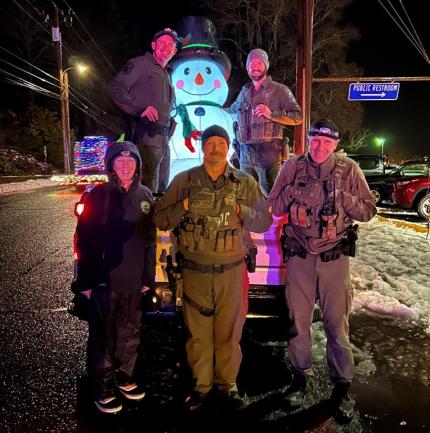
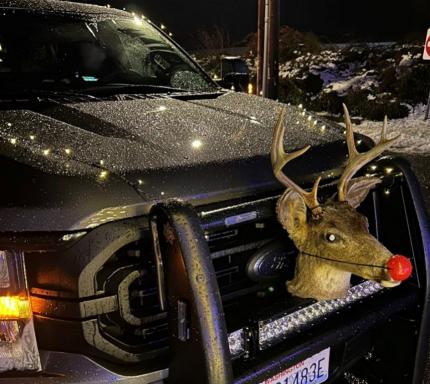
Managing Wildlife Populations
Streaked Horned Lark Working Group: Biologists Tirhi and Butler represented Region 6 at the annual working group meeting hosted by the Portland Airport. The agenda included presentations on research results including habitat enhancement and lark reintroduction, updates to the federal listings and federal recovery plans, updates from both Oregon and Washington wildlife departments regarding ongoing and planned lark work, an overview of the survey results from Oregon and Washington 2022-2023 (including on airfields), data management needs, and more.
Washington Department of Fish and Wildlife thanks Portland Airport for being such an excellent host and partner on lark recovery.
Mima Creek Unit, Oregon Spotted Frog and Waterfowl Grant Funding: In November, Biologist Tirhi gave a grant request presentation to the Aquatic Species Restoration Plan (ASRP) Regional Implementation Team review board. The grant presentation was for Phase 2 of the Mima Creek Unit of the Scatter Creek Wildlife Area Oregon spotted frog/fisheries project. Phase 2 requests $122,427 towards design completion, permitting, and cultural review for the construction of two ponds, hydrologic connector to deep water Mima Creek tributary, manual gate pond water control installation, and the installation of several beaver dam analogs into Mima Creek. After receiving a unanimous thumbs up by the review board, Tirhi completed and submitted the next step of the grant request.
Biologists Tirhi and Novak met with Ducks Unlimited staff members to discuss the early stages of project implementation after being notified that the $1.3M Washington State Department of Fish and Wildlife and Ducks Unlimited (DU) North American Wetland Conservation Act (NAWCA) grant was awarded. Mima Creek will receive $310,000 from the NAWCA grant to enhanced wetlands for waterfowl and other species.
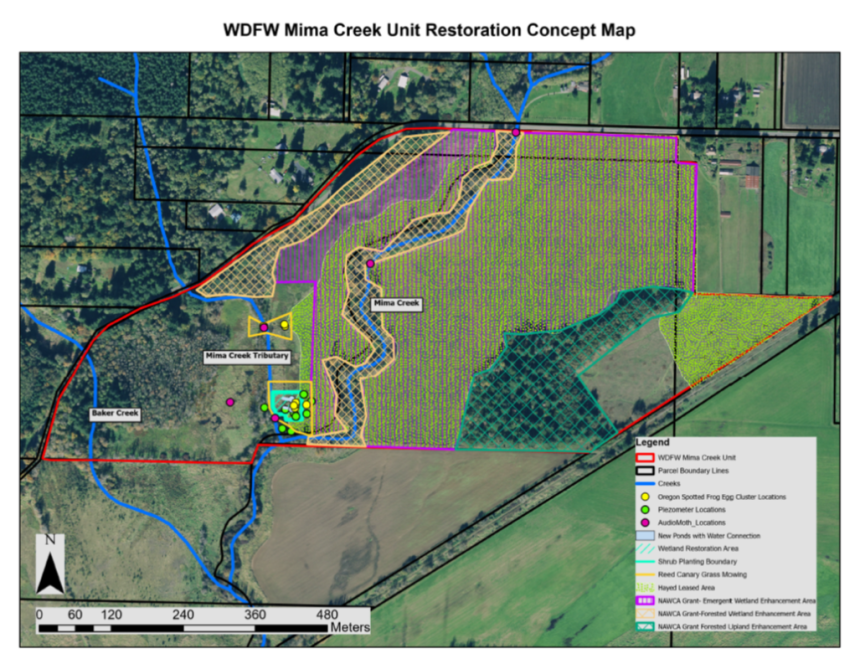
Western Pond Turtle: Biologists Butler and Tirhi represented Region 6 at the annual internal pond turtle planning meeting which was also attended by Region 5 and headquarters staff members. This is the annual opportunity for those Washington State Department of Fish and Wildlife biologists responsible for management of the eight pond turtle recovery sites to discuss and plan the past and upcoming turtle seasons and turtle recovery. The team presented their 2023 survey results and data collection including radio tagged breeding females and nesting results. They also discussed and planned research needs including disease response (USD), husbandry, and grant opportunities. This annual internal meeting is always followed at a future date with the larger partnership that includes Woodland Park Zoo, Oregon Zoo, PAWS, Sustainability in Prisons Project, and others.
Barred Owl and Common Loon: Biologist Tirhi represented District 11 by attending the internal discussion on barred owl removal project Barred Owl Management | U.S. Fish & Wildlife Service (fws.gov) and the internal planning discussion for common loon surveys and needs.
Providing Recreation Opportunities
Chimacum Unit Gate: Capital Asset Management Program (CAMP) staff members installed a gate at the Chimacum Unit in the North Olympic Wildlife Area to help allow emergency vehicles and vegetation maintenance equipment into the unit.
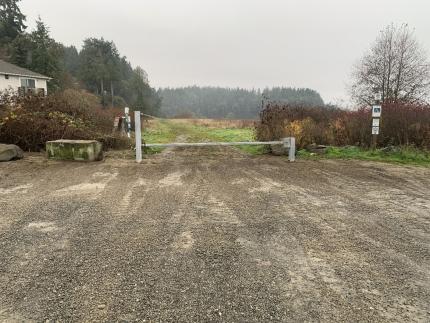
Johns River Kiosk Repair: Assistant Manager Gallegos, Technicians Magliaro and Martinez, and staff members at the Olympic-Willapa Hills Wildlife Area recently refurbished the kiosk at the Johns River Unit and water access area. Infrastructure such as wooden kiosks weather quickly in coastal areas and are often subject to deterioration of the lumber, moss and mold growth, loss of shingles, in addition to normal wear and tear.

Conserving Natural Landscapes
Interstate 5 (I-5) Connectivity Project: Biologist Tirhi represents Region 6 on the technical team for this project. She participated in the Connectivity Technical Team field trip to visit and discuss the various I-5 crossing locations that have been proposed. The team saw wildlife camera data from cameras positioned at the proposed locations showing big wildlife (bears, cougar) and small wildlife (bobcat, coyote, birds) attempting to cross or interested in crossing the interstate. Tirhi was surprised by how close the wildlife got to I-5 before deciding not to cross.
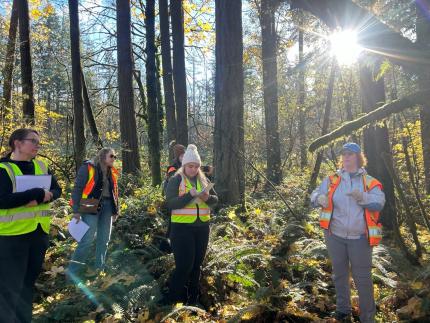
Conducting Business Operations and Policy
Personnel Development Plan: Biologist Tirhi met with Biologist Butler to complete her annual evaluation and expectations review for 2023-2024. This was a time to review the excellent work Biologist Butler provides to the agency and highlight expected work for this next season. The wildlife of District 11 is better off due to the hard work of biologists like Biologist Butler.